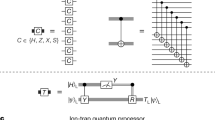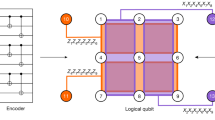Abstract
A successful quantum error correction protocol would allow quantum computers to run algorithms without suffering from the effects of noise. However, fully fault-tolerant quantum error correction is too resource intensive for existing quantum computers. In this context, we develop a quantum error detection code for implementations on existing trapped-ion computers. By encoding k logical qubits into k + 2 physical qubits, this code presents fault-tolerant state-initialization and syndrome-measurement circuits that can detect any single-qubit error. It provides a universal set of local and global logical rotations that have physical support on only two qubits. A high-fidelity—although non fault-tolerant—compilation of this universal gate set is possible thanks to the two-qubit physical rotations present in trapped-ion computers with all-to-all connectivity. Given the particular structure of the logical operators, we nickname it the Iceberg code. We demonstrate the protection of circuits of eight logical qubits with up to 256 layers, saturate the logical quantum volume of 28 and show the positive effect of increasing the frequency of syndrome measurements in the circuit. These results illustrate the practical usefulness of the Iceberg code to protect expressive circuits on existing trapped-ion quantum computers.
This is a preview of subscription content, access via your institution
Access options
Access Nature and 54 other Nature Portfolio journals
Get Nature+, our best-value online-access subscription
$29.99 / 30 days
cancel any time
Subscribe to this journal
Receive 12 print issues and online access
$209.00 per year
only $17.42 per issue
Buy this article
- Purchase on Springer Link
- Instant access to full article PDF
Prices may be subject to local taxes which are calculated during checkout




Similar content being viewed by others
Data availability
The data that support the findings of this study are available at Zenodo45. Source data are provided with this paper.
Code availability
Code to reproduce the findings of this study is available from the corresponding authors on reasonable request.
References
Gottesman, D. An introduction to quantum error correction and fault-tolerant quantum computation. Proc. Sym. Ap. 68, 13–58 (2010).
Lidar, D. A. & Brun, T. A. Quantum Error Correction (Cambridge Univ. Press, 2013).
Orzel, C. Quantum Simulation (IOP, 2017).
Harrow, A. W., Hassidim, A. & Lloyd, S. Quantum algorithm for linear systems of equations. Phys. Rev. Lett. 103, 150502 (2009).
Shor, P. W. Polynomial-time algorithms for prime factorization and discrete logarithms on a quantum computer. SIAM J. Sci. Comput. 26, 1484–1509 (1997).
Gidney, C. & Ekerå, M. How to factor 2048 bit RSA integers in 8 hours using 20 million noisy qubits. Quantum 5, 433–464 (2021).
Allcock, J. et al. The prospects of Monte Carlo antibody loop modelling on a fault-tolerant quantum computer. Front. Drug Discov. 2, 908870 (2022).
Chen, Z. et al. Exponential suppression of bit or phase errors with cyclic error correction. Nature 595, 383–387 (2021).
Ryan-Anderson, C. et al. Realization of real-time fault-tolerant quantum error correction. Phys. Rev. X 11, 041058 (2021).
Acharya, R. et al. Suppressing quantum errors by scaling a surface code logical qubit. Nature 614, 676–681 (2023).
Postler, L. et al. Demonstration of fault-tolerant universal quantum gate operations. Nature 605, 675–680 (2022).
Ryan-Anderson, C. et al. Implementing fault-tolerant entangling gates on the five-qubit code and the color code. Preprint at https://doi.org/10.48550/ARXIV.2208.01863 (2022).
Suzuki, Y., Endo, S., Fujii, K. & Tokunaga, Y. Quantum error mitigation as a universal error reduction technique: applications from the nisq to the fault-tolerant quantum computing eras. PRX Quantum 3, 010345 (2022).
Cirac, J. I. & Zoller, P. Goals and opportunities in quantum simulation. Nat. Phys. 8, 264–266 (2012).
Harrow, A. W. & Montanaro, A. Quantum computational supremacy. Nature 549, 203–209 (2017).
Lund, A. P., Bremner, M. J. & Ralph, T. C. Quantum sampling problems, BosonSampling and quantum supremacy. npj Quantum Inf. 3, 15 (2017).
Knill, E. Fault-tolerant postselected quantum computation: schemes. Preprint at https://doi.org/10.48550/ARXIV.QUANT-PH/0402171 (2004).
Knill, E. Fault-tolerant postselected quantum computation: threshold analysis. Preprint at https://doi.org/10.48550/ARXIV.QUANT-PH/0404104 (2004).
Urbanek, M., Nachman, B. & de Jong, W. A. Error detection on quantum computers improving the accuracy of chemical calculations. Phys. Rev. A 102, 022427 (2020).
Schindler, P. et al. A quantum information processor with trapped ions. New J. Phys. 15, 123012 (2013).
Bruzewicz, C. D., Chiaverini, J., McConnell, R. & Sage, J. M. Trapped-ion quantum computing: progress and challenges. Appl. Phys. Rev. 6, 021314 (2019).
Grassl, M., Beth, T. & Rötteler, M. On optimal quantum codes. Int. J. Quantum Inf. 02, 55–64 (2004).
Chao, R. & Reichardt, B. W. Fault-tolerant quantum computation with few qubits. npj Quantum Inf. 4, 42 (2018).
Gidney, C. Cleaner magic states with hook injection. Preprint at https://doi.org/10.48550/arXiv.2302.12292 (2023).
Mølmer, K. & Sørensen, A. Multiparticle entanglement of hot trapped ions. Phys. Rev. Lett. 82, 1835 (1999).
System Model H1 powered by Honeywell. Quantinuum https://www.quantinuum.com/hardware/h1 (2022).
Pino, J. M. et al. Demonstration of the trapped-ion quantum ccd computer architecture. Nature 592, 209–213 (2021).
Linke, N. M. et al. Fault-tolerant quantum error detection. Sci. Adv. 3, e1701074 (2017).
Hines, J. et al. Demonstrating scalable randomized benchmarking of universal gate sets. Preprint at https://doi.org/10.48550/ARXIV.2207.07272 (2022).
Proctor, T. et al. Scalable randomized benchmarking of quantum computers using mirror circuits. Phys. Rev. Lett. 129, 150502 (2022).
Chao, R. & Reichardt, B. W. Quantum error correction with only two extra qubits. Phys. Rev. Lett. 121, 050502 (2018).
Proctor, T., Rudinger, K., Young, K., Nielsen, E. & Blume-Kohout, R. Measuring the capabilities of quantum computers. Nat. Phys. 18, 75–79 (2021).
Cross, A. W., Bishop, L. S., Sheldon, S., Nation, P. D. & Gambetta, J. M. Validating quantum computers using randomized model circuits. Phys. Rev. A 100, 032328 (2019).
Baldwin, C. H., Mayer, K., Brown, N. C., Ryan-Anderson, C. & Hayes, D. Re-examining the quantum volume test: ideal distributions, compiler optimizations, confidence intervals, and scalable resource estimations. Quantum 6, 707–736 (2022).
Qiskit Python package v.0.37.0, v.0.37.2, v.0.38.0. Qiskit Contributors https://pypi.org/project/qiskit/ (2022).
Itoko, T. & Imamichi, T. Scheduling of operations in quantum compiler. In 2020 IEEE International Conference on Quantum Computing and Engineering 337–344 (IEEE Computer Society, 2020).
Gokhale, P. et al. Quantum fan-out: circuit optimizations and technology modeling. In 2021 IEEE International Conference on Quantum Computing and Engineering (QCE) 276–290 (IEEE Computer Society, 2021).
Lao, L. & Browne, D. E. 2QAN: a quantum compiler for 2-local qubit Hamiltonian simulation algorithms. In Proc. 49th Annual International Symposium on Computer Architecture 351–365 (Association for Computing Machinery, 2022).
Nannicini, G., Bishop, L. S., Gunluk, O. & Jurcevic, P. Optimal qubit assignment and routing via integer programming. ACM Transactions on Quantum Computing 4, 7 (2022).
Stricker, R. et al. Experimental deterministic correction of qubit loss. Nature 585, 207–210 (2020).
Farhi, E., Goldstone, J. & Gutmann, S. A quantum approximate optimization algorithm. Preprint at https://doi.org/10.48550/ARXIV.1411.4028 (2014).
Amaro, D. et al. Filtering variational quantum algorithms for combinatorial optimization. Quantum Sci. Technol. 7, 015021 (2022).
Benedetti, M., Lloyd, E., Sack, S. & Fiorentini, M. Parameterized quantum circuits as machine learning models. Quantum Sci. Technol. 4, 043001 (2019).
van de Wetering, J. Constructing quantum circuits with global gates. New J. Phys. 23, 043015 (2021).
Self, C., Benedetti, M. & Amaro, D. Research data supporting ‘Protecting expressive circuits with a quantum error detection code’. Zenodo https://doi.org/10.5281/zenodo.8318683 (2023).
Acknowledgements
We thank C. Ryan-Anderson, N. Burdick, B. Neyenhuis, C. Baldwin, Y. Kikuchi, M. Fiorentini, D. Hayes, K. Mayer and Y.H. Chen for fruitful discussions and feedback on the manuscript. The experiments were done using the Quantinuum system model H1-2, powered by Honeywell ion traps.
Author information
Authors and Affiliations
Contributions
All authors conceived and designed the study. D.A. performed analytic calculations and C.N.S. carried out numerical studies. All authors analysed the data, interpreted the results and wrote the manuscript.
Corresponding authors
Ethics declarations
Competing interests
The authors declare no competing interests.
Peer review
Peer review information
Nature Physics thanks Crystal Noel and the other, anonymous, reviewer(s) for their contribution to the peer review of this work.
Additional information
Publisher’s note Springer Nature remains neutral with regard to jurisdictional claims in published maps and institutional affiliations.
Supplementary information
Supplementary Information
Supplementary Figs. 1–5, details about experiments and simulations, and references.
Supplementary Data 1
Statistical source data for Supplementary Fig. 1.
Supplementary Data 2
Statistical source data for Supplementary Fig. 3.
Supplementary Data 3
Statistical source data for Supplementary Fig. 5.
Source data
Source Data Fig. 2
Statistical source data.
Source Data Fig. 3
Statistical source data.
Source Data Fig. 4
Statistical source data.
Rights and permissions
Springer Nature or its licensor (e.g. a society or other partner) holds exclusive rights to this article under a publishing agreement with the author(s) or other rightsholder(s); author self-archiving of the accepted manuscript version of this article is solely governed by the terms of such publishing agreement and applicable law.
About this article
Cite this article
Self, C.N., Benedetti, M. & Amaro, D. Protecting expressive circuits with a quantum error detection code. Nat. Phys. 20, 219–224 (2024). https://doi.org/10.1038/s41567-023-02282-2
Received:
Accepted:
Published:
Issue Date:
DOI: https://doi.org/10.1038/s41567-023-02282-2



